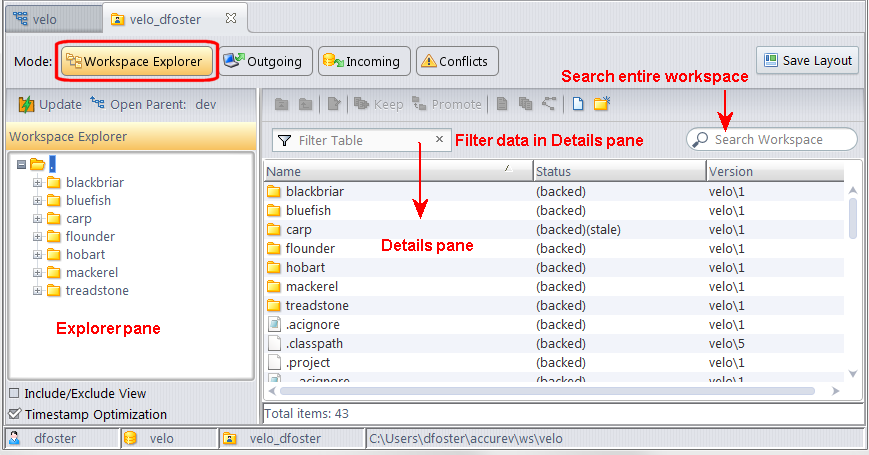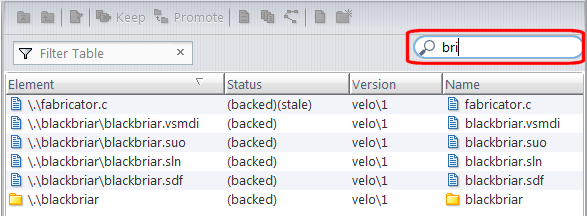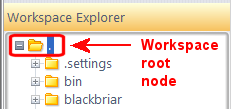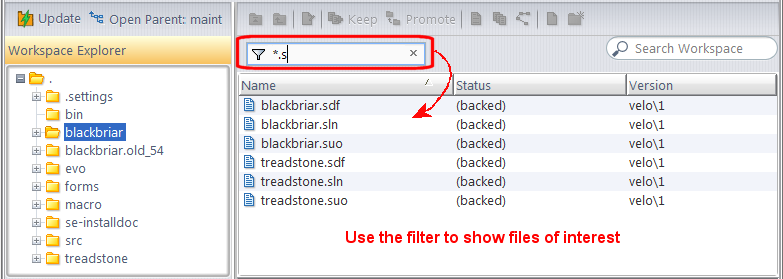Explorer Mode
The Explorer mode displays the files and directories that are in the current workspace or stream, as shown in the following illustration of the workspace File Browser. The Explorer mode is selected by default when you open the File Browser for a workspace or a stream. (See File Browser Modes for information on other modes.)

The Explorer and Details Panes
Generally speaking, the Explorer mode displays all the contents of the current stream or workspace. When you select a directory in the Explorer pane, the Details pane shows only the files and subdirectories for that directory.
Note the following settings, however, which can affect what files and directories are displayed in the Explorer and Details panes and how AccuRev determines whether or not a file should have a status of (modified).
- Include/Exclude View Option — The Include/Exclude view lets you review and set rules that influence which directories and files are visible in the Explorer and other File Browser modes. See Including and Excluding Files for more information.
- Timestamp Optimization Option — By default, AccuRev uses cached server information to identify which files in the workspace should have a status of (modified). To learn more about this option and when you might want to turn it off, see Timestamp Optimization (TSO) in the AccuRev Administrator’s Guide. See AccuRev Element Status Reference for a discussion of (modified) and other statuses.
In addition, you can instruct AccuRev to ignore any files and directories that are not under AccuRev control. See Controlling the Display of External Objects for more information .
Details Pane Toolbar Reference
The following table summarizes the tools available on the Details pane toolbar and where to find more information.
| Tool | Description | Available For... |
|---|---|---|
|
|
Displays the contents of the workspace’s (and stream's) top-level directory. | Workspace and Stream |
|
|
Displays the contents of the current directory's parent. If the current directory is the target of a directory link, this command switches to the target's parent, not to the directory containing the link. | Workspace and Stream |
|
|
Opens the selected file in a text editor. See Editing a File. | Workspace |
|
|
Saves your work by creating a new version in the workspace stream. See Keep: Creating a New Version. | Workspace |
|
|
Shares your work with others by sending the selected files to the backing stream. See Promote: Sharing Your Work. | Workspace and Stream |
|
|
Backs out changes by sending the selected files to a child stream or workspace. See Demote: Moving Elements Out of a Stream. | Stream |
|
|
Lists the contents of the selected text file, annotating each line. See Annotate: Reviewing Transactions on an Element. | Workspace and Stream |
|
|
Displays the transactions associated with the selected element in the History Browser. See The History Browser. | Workspace and Stream |
|
|
Displays all the versions, and their relationships, of the selected element in the Version Browser. See The Version Browser. | Workspace and Stream |
|
|
Creates a new file in the current workspace. See Creating a New File . | Workspace |
|
|
Creates a new folder in the current workspace. See Creating a New Folder . | Workspace |
|
|
Hides/shows the Diff pane in Outgoing Changes, Incoming Changes, and Conflicts modes. See The Diff Pane. | Workspace and Stream |
How the Workspace Explorer Differs from the Stream Explorer
While the Explorer mode is similar for workspaces and streams, the workspace File Browser provides features and functionality that take advantage of its direct access to your local file system. These features include:
- Workspace search -- The workspace File Browser lets you search the entire workspace. See Searching the Workspace below for more information.
- Update -- By definition, the Update command refreshes the workspace with changes from the parent stream, so Update is available only in the workspace File Browser. (In AccuRev, streams inherit changes from parent streams automatically.) See Updating Your Workspace for more information.
- File-based operations -- You can accomplish any operation that requires direct access to your local file system using the workspace File Browser — creating, editing, renaming, or deleting a file; cut/copy/paste operations; locking a file using AccuRev’s anchor command; and so on. See Common Usage Scenarios for more information.
Identifying Current Workspace Location
In the workspace File Browser, indicators at the bottom of the AccuRev GUI window show the name and location of the current workspace.
In the stream File Browser, only the names of the current user and depot are displayed.
Searching the Workspace
The Search Workspace field in the Workspace Explorer mode lets you search the current workspace for any files and directories whose name matches the string you enter. You can enter any character that is legal for an AccuRev element name. (See User-Specified Names for AccuRev Entities for details.) Wildcards ("*" and "?") are accepted. If you do not use wildcards, AccuRev searches the workspace for any object whose name contains the string you enter. Entering "bri" returns both fabricator.c and all blackbriar files and directories, for example:

Note: In addition, search is available only for locally accessible workspaces, not for workspaces on a different machine. Search is also not available for streams. The scope of the search is determined by the currently selected node in the Workspace Explorer tree. For example, if you select a specific folder, AccuRev searches only that folder for objects that match the string you enter in the Search Workspace field. (AccuRev changes Workspace to the name of the folder you select to reinforce this point.) If you want to search the entire workspace, be sure to first select the workspace root node in the Workspace Explorer tree.
To search the current workspace:
Select the workspace folder you want to search. If you want to search the entire workspace, select the root node.

- In the Search Workspace field, enter the string or name you want to search the workspace for. You can use "*" and "?" wildcards.
- Press Enter.
- Depending on the size of the workspace, AccuRev displays a status box while it searches the workspace for the files and directories that match the string you entered in the Search Workspace field.
- Click the Run in Background button if you want to do other things while AccuRev searches.
Search results are displayed in the Details pane when the search is complete. If the search results return a directory, you can double-click it to view directory contents in the Details pane. The directory tree in the Workspace Explorer expands and selects the correct node/directory.
To clear the search field:
- Delete the current entry in the Search Workspace field.
- Press Enter.
Filtering the Details Pane Table
You can use the Filter Table field to filter the objects displayed in the Details pane. As you type, the Details pane is filtered to show only those objects containing the characters you enter. The rules for filter strings are the same as for the search.

To clear the filter, click the X button in the Filter Table field.












